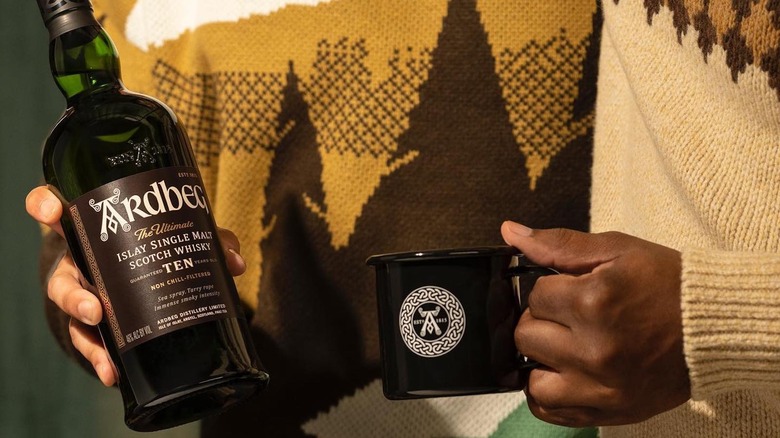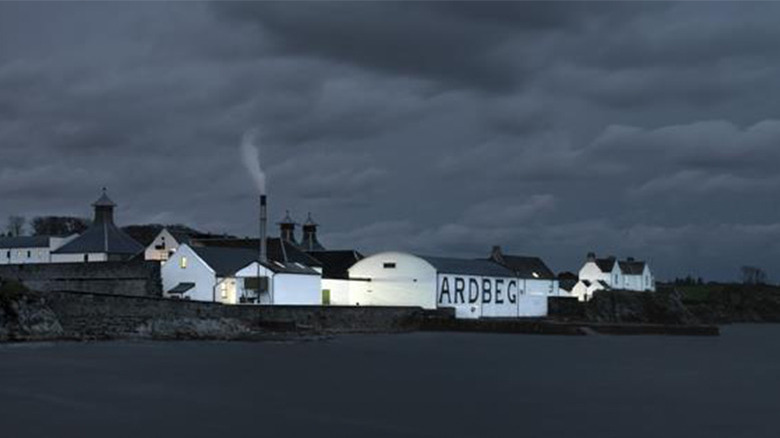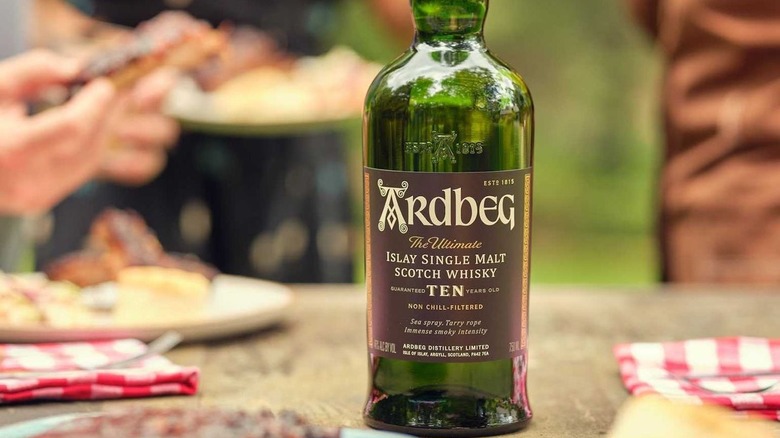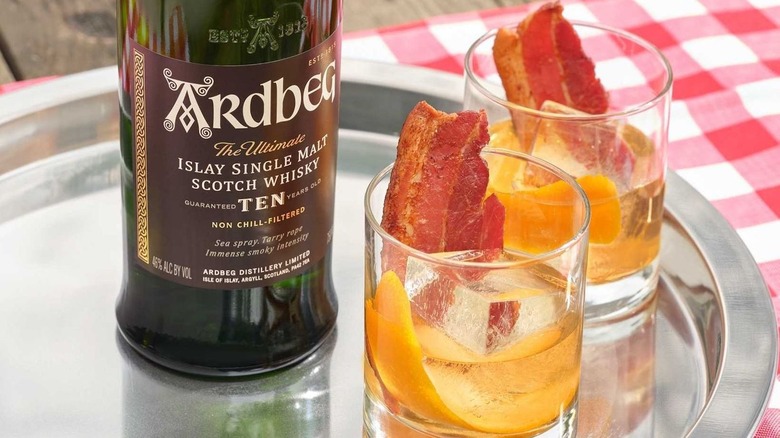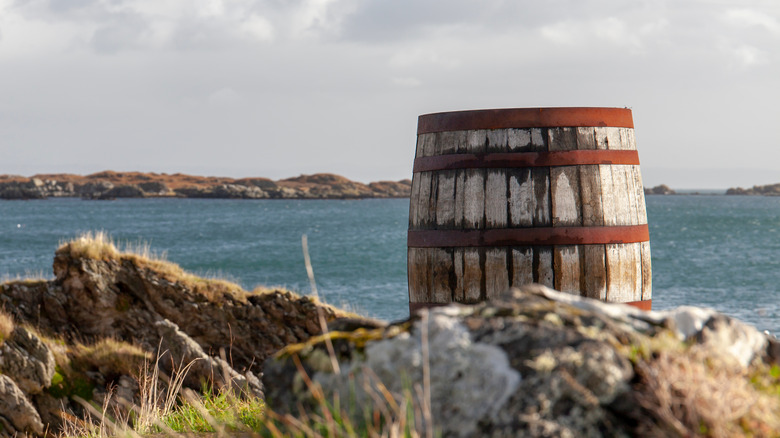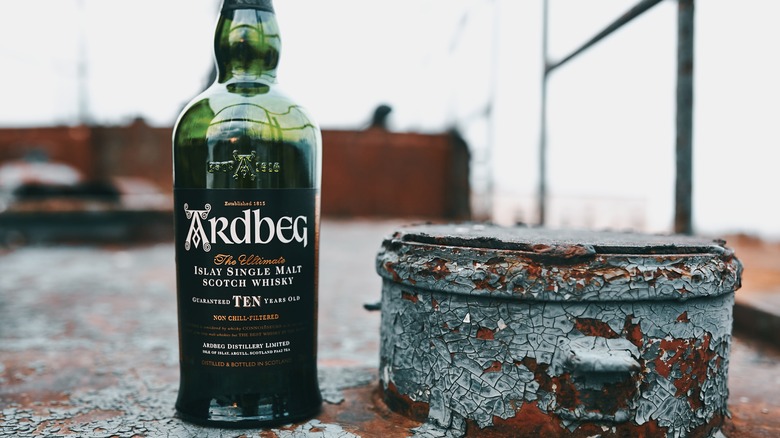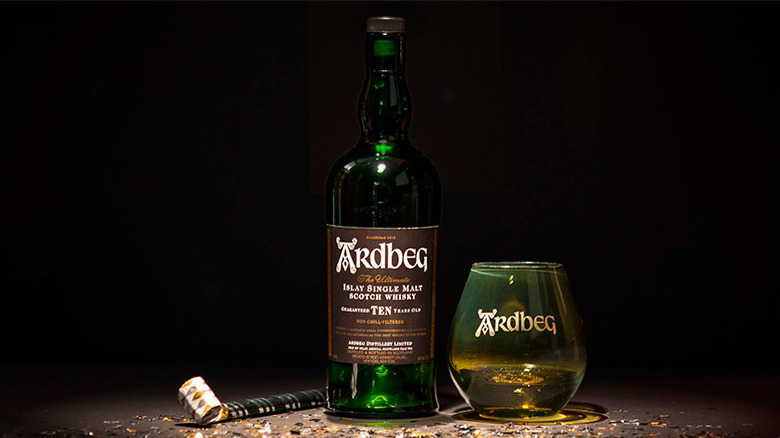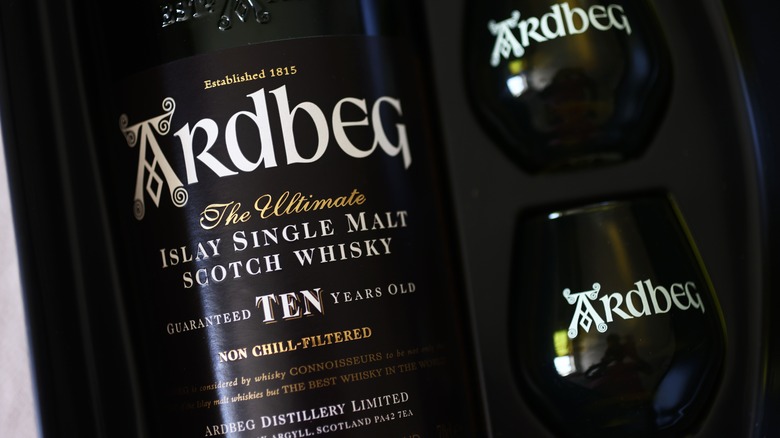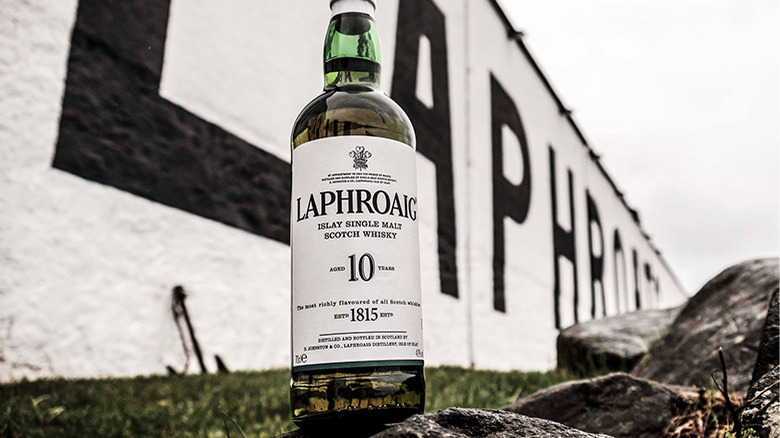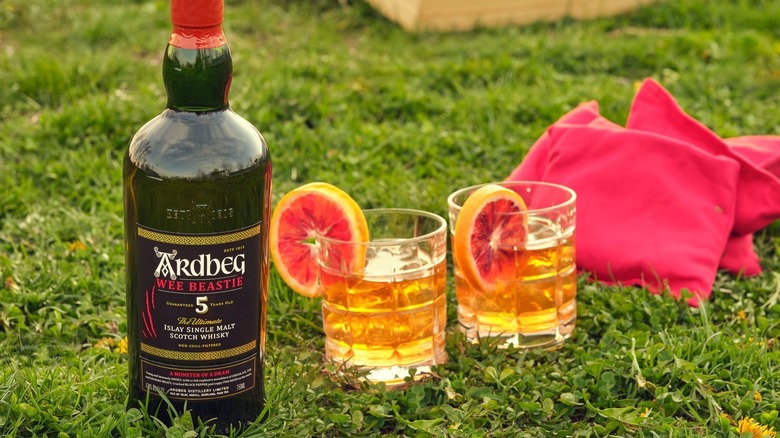Ardbeg 10-Year Single Malt Scotch: The Ultimate Bottle Guide
The scotch region of Islay, an isle on the western coast of Scotland, produces some of the most beloved, complex, and unique whiskies in the world. The scotch-making tradition of Islay is one that dates back centuries and is characterized by one unifying factor: peat. Peated scotches are made by infusing the barley with the smoke of peat, which is essentially layers of soil. This makes for an earthy, smoky whisky that is brawny, potent, and, admittedly, polarizing. However, there is a common misconception that peat is the only factor that makes Islay scotches what they are, but every factor that goes into a whisky makes a difference.
Everything from the barley that grows there to the coastal environment, in general, contributes to making Islay scotch so special, and Ardbeg 10-Year is one of its most fundamental expressions. Ardbeg has been a longtime leader of the Islay scotch world, despite having a brief era of inactivity (more on that later).
Its signature 10-Year whisky is made to be one of the peatiest scotches on the market in the very best way possible. Here is everything you need to know about this one-of-a-kind scotch and the historic brand behind it.
History of Ardbeg
If you look at any bottle of Ardbeg scotch, you will see that the distillery was established in 1815. What you may not know, is that the brand's founder, John MacDougall, had been distilling his soon-to-be-famous whisky illegally long before that. The earliest records of the Ardbeg distillery producing scotch date back to 1794 before MacDougall attained a license to do so. Regardless, the operation was finally made legal nearly 20 years later. Despite a change in ownership in 1838 when Thomas Buchanan purchased the distillery, the MacDougalls remained in charge.
Throughout the rest of the 19th century, Ardbeg became the most successful scotch distiller in Islay. Because the kilns used to peat the mash did not have fans for ventilation, the peat smoke was more concentrated in the barley, resulting in a more intensely flavored whisky. This made Ardbeg very desirable for blenders across Scotland, according to Mark Littler, which is what fueled most of the distillery's business in addition to selling the whisky as a regular single malt around the world. By 1887, Mark Littler reports that Ardbeg was said to have been producing 250,000 gallons of its whisky annually, which, in addition to its 60 employees, made it the largest and most dominant scotch maker in its region.
Ardbeg was one of the first woman-run distilleries
There is no doubt that the world of whisky, and spirits in general, is a male-dominated industry. Despite more and more women establishing, owning, and running spirits brands today, there is still more progress to be made. Ardbeg's history, though, includes some of the earliest forms of this progression.
After Thomas Buchanan bought the Ardbeg distillery from John MacDougall in 1838, a transaction worth only £1,800 by the way, John's son Alexander stayed in charge of the whisky production. Once he died in 1853, his role as distillery manager was passed down to his three children: Colin, Margaret, and Flora.
Although Bessie Williamson of the Laphroaig distillery is widely recognized as the first woman ever to own a distillery, Flora and Margaret MacDougall are among the first women to ever run one. Looking back on how prominent Ardbeg became during their time in charge with their brother, the strides they made for women in the spirits industry are certainly notable.
The distillery fell victim to the infamous Whisky Loch
Even though Ardbeg grew to become one of the most successful brands of scotch in the world not too long after it was founded, there was a period of time when it looked as though it would close for good. In the 1980s, a massive decrease in demand, known as the Whisky Loch, completely decimated the industry. This sudden drop came after decades of high demand, so when it occurred, distillers were left with a surplus of whisky and no one to sell it to, reports VinePair. One of these distilleries was Ardbeg, which had no choice but to shut down in 1981, and in 1989 reopened under new ownership but closed again in 1996, a brief period that saw little to no growth.
Luckily, the year after it closed for the second time, Ardbeg was bought again, this time by scotch giants Glenmorangie. The new owners took advantage of the whisky left behind after the Whisky Loch decades prior and introduced a 17-Year expression as its first release, followed by a 25-Year shortly after. Actually, it was not until 2008 that Ardbeg came out with what is now its flagship bottle, Ardbeg 10-Year.
Ardbeg holds the record for the most expensive cask sold
The world of luxury spirits is quite astounding. Rare bottles, exclusive releases, and a combination of the two, can go for some exorbitant prices. Scotch whisky has contributed some collector's items of its own. The most expensive cask of whisky ever sold, though, was produced by Ardbeg. In 2022, a cask of Ardbeg's scotch that was distilled in 1975 sold for £16 million, which amounts to about $19.5 million. The cask was sold privately to a collector in Asia.
To put the sale price into perspective, the price Glenmorangie paid to acquire the Ardbeg brand in 1997 was £7 million. Believe it or not, a rare cask of whisky selling for this sort of price is not that uncommon. Over the past several years, the market for such whiskies has exploded. In fact, this record-breaking sale came mere months after one that sold for one million pounds less.
Ardbeg's scotch made it all the way to space
Excluding its period of inactivity, Ardbeg has been producing scotch for over two centuries. However, they are still committed to trying new things and not being held back by traditions. In 2011, Ardbeg sent a vial of its un-aged whisky into orbit to the International Space Station.
The idea behind the experiment was to see what effect the environment would have on the distillate, according to the BBC. Upon the vial's return to Earth three years later, Ardbeg compared it to an identical distillate that remained at its distillery in Islay. The brand's director of distilling, Dr. Bill Lumsden, says to the BBC that he found a "noticeable difference" between the two samples, pointing out differences in both aroma and flavor notes.For example, Lumsden claims that the peat character of the space sample was different than normal and completely unique, a result of a change in the whisky's terpenes, the properties inside it that translate to taste. Other media sources say it tasted strange.
This seems to only be the beginning of Ardbeg exploring the unknown possibilities, but the brand is keen on innovation and unlocking as much complexity in its scotch as possible.
How is Ardbeg 10-Year made?
The reason behind the intense smokiness in Ardbeg 10-Year starts at the very first step of the process of making it. The malt used for this scotch has a peat level of 50 ppm, or parts per million phenol, a measurement of a malt's peatiness. At 50 ppm, Ardbeg 10-Year is one of the most phenolic whiskies out there. Ardbeg used to have its own floor maltings at its distillery but has been getting its malted barley from an off-site location since the early 1980s. This malt is combined with water said to be taken from the distillery's private source, Loch Uigeadail, found just three miles away.
After the added water extracts the right amount of sugar, the mash is ready for fermentation, a process that the brand says lasts longer than most other whiskies because of the high amount of phenol in the malt. The liquid is distilled two separate times to achieve an alcohol content of roughly 63% ABV, after which it's transferred into maturation casks. There are many scotches in the Ardbeg catalog that are aged in different types of wood, but its flagship 10-Year is aged in ex-bourbon barrels.
The barrels used are both first-fill and second-fill casks, which help achieve consistency and get the most character out of the wood. After 10 years of aging, the whisky is finally bottled at an ABV of 46%, distributed across the globe, and makes its way into our glasses.
What does Ardbeg taste like?
With such a high PPM, Ardbeg 10-Year is dominated by peat and smoke. If you have never had a peated whisky before, this one is definitely a prolific introduction that does not pull any punches. Peat is a characteristic of scotch that can be polarizing, and it is certainly not for everyone. However, there are peated whiskies that overdo it. Ardbeg 10-Year, though, manages to capture a rich depth of peatiness that is not excessive or abrasive. These characteristics are intense, indeed, but if you seek them out, Ardbeg 10-Year provides them in a positively fundamental way.
The robust peat in Ardbeg 10-Year is supported by an array of more gentle flavor notes that make this scotch more than just an intensely peated whisky. The peat and smoke are accompanied by subtle hints of the salty brine from the coast. These flavors do not only come from the malt and water used to make the scotch, they creep into it during the maturation process due to its close proximity to the sea. Although subtle, they are delightfully light supports to the richness of the peat.
The 10-Year maturation also gives Arbdeg a bounty of barrel notes that are particularly complimentary to its bold character. The ex-bourbon casks provide notes of vanilla and caramel that help to round out the burliness to bring everything to a cohesive balance.
How to drink Ardbeg 10-Year?
As is the case with any spirit, how you prefer to drink it is entirely up to you. Try not to get caught up in what is considered right or wrong, because as long you like it, you're doing it right. That being said, there are certain things you can do to get the most out of a whisky as complex and bold as Ardbeg 10-Year, the most fundamental being glassware. The best glass to sip a whisky out of is one that will allow room for both your nose and your mouth simultaneously. A lot of enjoying whisky is taking in its aromas, so doing so while you take a sip only makes your experience better.
Ideally, a Glencairn glass is the best option; the tulip-shaped glasses are designed specifically for sipping whisky. The voluptuous body allows the scotch to breathe and retains its aromas, and the sturdy base allows you to hold the glass without warming up what's inside it. If you do not have a Glencairn glass, a regular lowball glass or even a smaller-volume wine glass will do just fine.
If you are a scotch beginner or have not had much exposure to peated scotch, you can make your first try of Ardbeg 10-Year more approachable by diluting it with a small amount of water. This will take away any alcoholic burn and let you appreciate the many flavor notes and aromas more freely.
Is Ardbeg expensive?
Given the long history and unique and intense character, Ardbeg 10-Year remains one of the more affordable Islay scotch whiskies on the market. According to Wine-Searcher, a bottle of Ardbeg 10-Year costs an average of $63. This puts it right in the same price range as some competing bottles with the same age statement — and even more affordable than others.
If you have never had Ardbeg 10-Year before or never had a peated Islay scotch before, committing to a whole bottle may, understandably, be considered chancy. Obviously, there is no guarantee that you will like a whisky like Ardbeg 10-Year if you have never had peated scotch before. Once again, it can be a polarizing style.
What you can expect from Ardbeg 10-Year, though, is that it is one of the best Islay scotches on the market, especially for its price tag. Plus, even if you find that it is not exactly for you, you are more than likely to have a guest at some point delighted to find that you have this whisky on hand.
Ardbeg 10-Year vs Laphroaig 10-Year
Of all the whiskies made on Islay, Laphroaig 10-Year is the most comparable to Ardbeg 10-Year. Both distilleries were officially established in 1815, both are peated and aged for 10 years, and the two are made only about two miles from one another. You would think that this would make for identical scotches, but Ardbeg and Laphroaig's flagship whiskies are very different.
For one, the peat that goes into each comes from different places, which translates to different flavors. As mentioned earlier, Ardbeg gets its malted barley from an off-site source in Port Ellen, whereasLaphroaig owns its own peat beds, which makes for an entirely unique flavor specific to the distillery. Laphroaig 10-Year's flavor, while complex and diverse, is definitely less approachable to scotch newcomers. Where Ardbeg 10-Year has grassy and earthy notes supporting the peat and smoke with softening barrel notes rounding them out, Laphroaig 10-Year has an almost medicinal character. This is not to say that it is not a good scotch, it is actually a great one, but its balance is skewed in the favor of potency.
In regards to price point, both bottles are basically the same, so depending on where you shop for scotch, chances are these two will only be a few dollars apart. But, in terms of achieving beauty in simplicity, Ardbeg 10-Year comes out on top.
Ardbeg crafts multiple expressions
Ardbeg 10-Year is the signature bottle of the brand's lineup, but it's far from the only one. There are multiple expressions in the permanent range of Ardbeg, one of which was added recently. Ardbeg Wee Beastie is a five-year scotch matured in both ex-bourbon and Oloroso sherry casks. It may only be five years old, but you'll be surprised at how much character it holds.
Another Ardbeg expression is Ardbeg An Oa, a whisky made by marrying whisky from traditional oak, ex-bourbon, and PX sherry casks, to name a few. An Oa tastes just like the flagship 10-Year, just with added influence from this diverse aging background. Ardbeg Correyvrecken is named after the whirlpool found off the northern coast of Islay. This scotch is sure to pack a punch at 57.7% ABV, but it remains approachable and well-rounded. In fact, it was awarded the World's Best Single Malt in 2010 by the World Whisky Awards.
If you find that you like the peat and smoke of Ardbeg 10-Year, then you have to go the extra step further with Ardbeg Uigeidail. This scotch was voted by the Ardbeg Committee, a fan club of the brand, as its favorite Ardbeg expression. This scotch is made up of ex-bourbon and Oloroso sherry scotches of varying ages, which dominate the profile. The intense peat and smoke are bolstered up at over 54%, but the rich sherry balances it out with its dry fruitiness.
